Workers' abilities that led to a speedy recoveryfrom the Great East Japan Earthquake.
NEC Network Products was originally founded in 1973 as NEC Fukushima. A merger in 2000 turned it into NEC Wireless Networks. The current company name was given in 2011, when it was integrated with NEC Tohoku–which was the main factory and part of the NEC Group scattered across the Tohoku and northern Kanto regions–and NEC Anten , based in the city of Nasushiobara, Tochigi Prefecture, to represent the NEC Group’s united efforts in tackling difficult problems.
The company’s main factory in Fukushima city is the “mother factory” for manufacturing the NEC Group’s communications products. NEC Network Products wants the factory’s production technology department members to support the expansion of the NEC Group’s production worldwide.
NEC Network Product’s foray into space equipment began, with regards to domestic products, with designing the power supply for communications equipment on board Kakehashi, the Communications and Broadcasting Engineering Test Satellite (COMETS) launched in 1998, and producing the power supply for communications equipment on board Hayabusa, the asteroid probe launched in 2003. Since then the company has been involved in projects including space communications equipment power supplies, solid-state power amplifiers and low-noise amplifiers by devoting efforts towards the manufacture of hybrid integrated circuits (HICs), which are essential components for these devices.
The Great East Japan Earthquake that struck on March 11, 2011 affected the line in the clean rooms where NEC Network Products makes space communications equipment, while blackouts and interrupted water supplies cut off the air conditioning and otherwise inflicted damage. However, the company resumed production of general equipment on March 14. As for space communications equipment, NEC Network Products won the understanding of JAXA, satellite system makers in Japan and abroad regarding the effect the earthquake had on its manufacture of this equipment and the steps the company took to deal with it. The company then managed to resume manufacturing of these components 19 days later on March 30.

Inside a clean room on March 11, immediately after the earthquake (left photo) and after it was restored on March 29 (right photo). Production was allowed to resume in the clean room on March 30 after final confirmation was made.
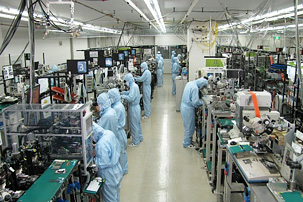
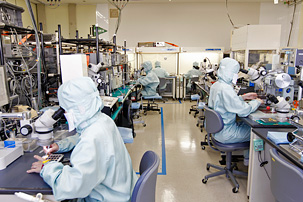
NEC Network Products’ main factory in Fukushima city is the “mother factory” for the manufacture of the NEC Group’s communications products.
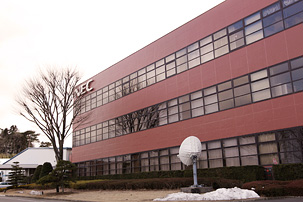
This is the assembly line for HICs, a key component for space communications equipment that is manufactured in a Class 10,000 (Fed.209D) clean room.

Skilled workers nimbly and accurately place chips to create the properties intended by designers.
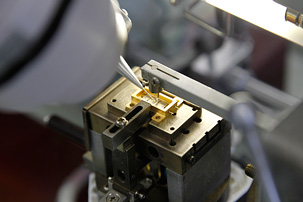
Manually operated machines are used for the wires and bonding that connects chips to circuit boards to maximize high frequency properties. Only workers who pass a skills test are allowed to do this.
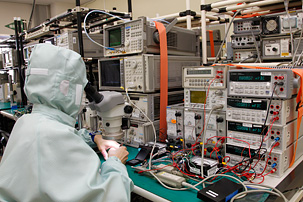
Here, assembled HICs are undergoing adjustments while having their electrical properties measured.
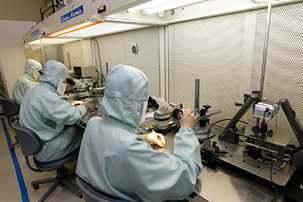
No foreign substances are allowed on the components, even as small as 1μm. Workers carefully verify cleanliness with microscopes.
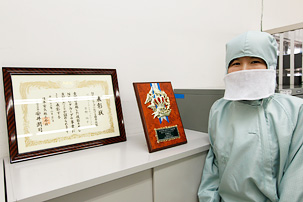
Mitsuko Kanno, who works on HIC assembly, was recognized in 2011 as a Superior NEC Group Technician.
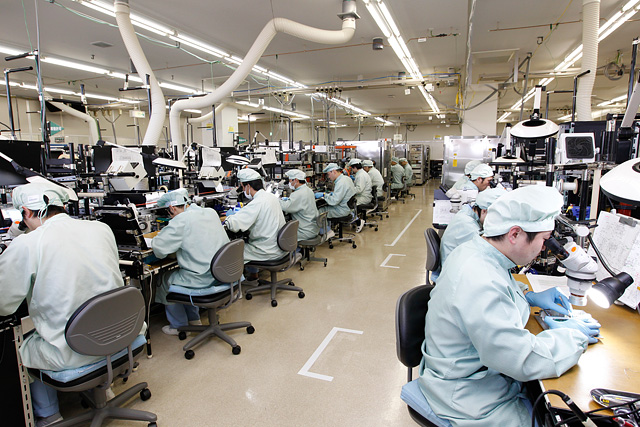
The space communications equipment assembly line is designed with a flow shop approach to improve production efficiency.
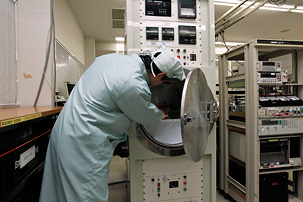
NEC Network Products uses a small vacuum chamber (left photo) and vibration tester (right photo) to reproduce conditions in space and during launch to verify that completed space communications equipment can tolerate those environments.
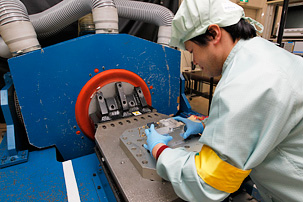
NEC NETWORK PRODUCTS
INTERVIEW
インタビュー
Workers with advanced skillsbuild ultra-high performanceHICs for space
NEC NETWORK PRODUCTS
Development Department Expart
Bunsuke Ogawa
